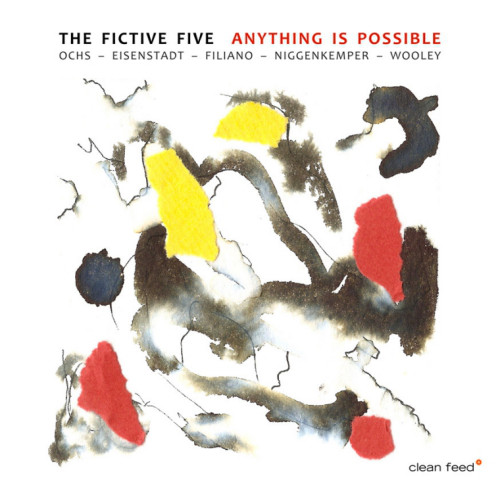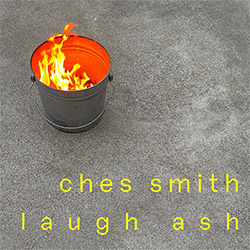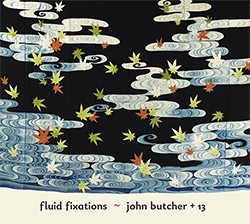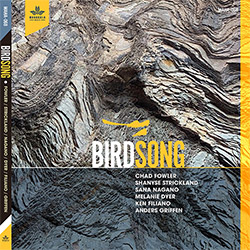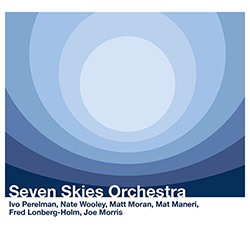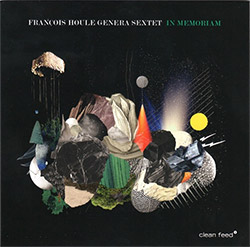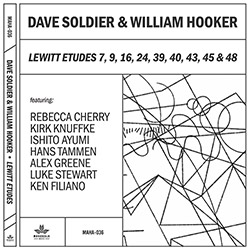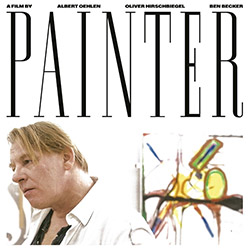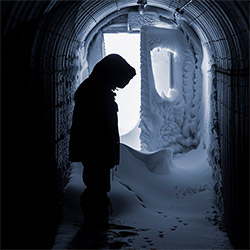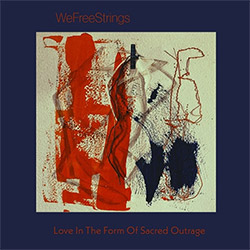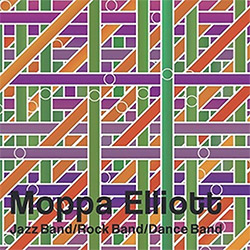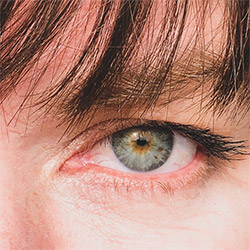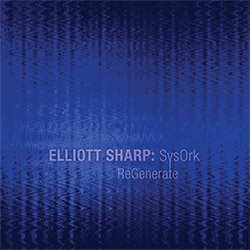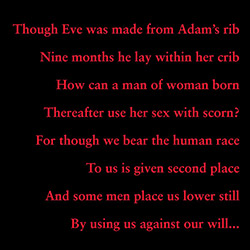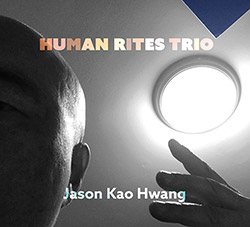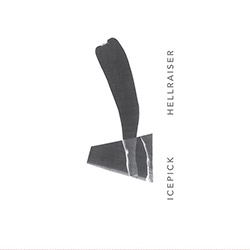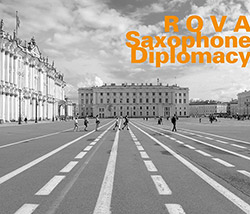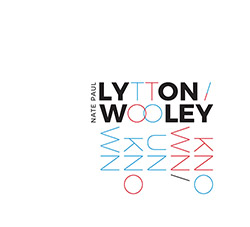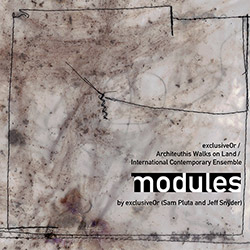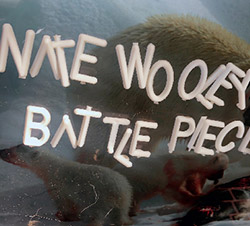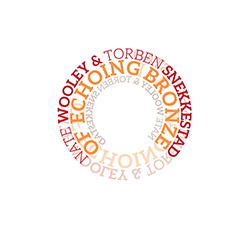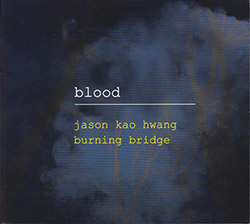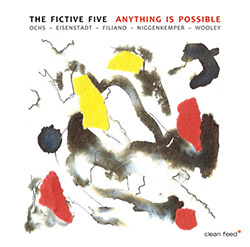
A tour-de-force of modern creative jazz from the quintet of Larry Ochs on tenor & sopranino saxophones, Nate Wooley on trumpet, Ken Filiano on bass & effects, Pascal Niggenkemper on bass & effects, and Harris Eisenstadt on drums, the familiar history of the musicians and the staggering skill of each bearing out the album's title, in 2 collective and 3 Ochs compositions.
Save $1.40
In Stock
Quantity in Basket: None
Log In to use our Wish List
Shipping Weight: 2.00 units
Sample The Album:
Larry Ochs-tenor saxophone, sopranino saxophone
Nate Wooley-trumpet
Ken Filiano-bass, effects
Pascal Niggenkemper-bass, effects
Harris Eisenstadt-drums
Click an artist name above to see in-stock items for that artist.
UPC: 5609063005141
Label: Clean Feed
Catalog ID: CF514
Squidco Product Code: 27345
Format: CD
Condition: New
Released: 2019
Country: Portugal
Packaging: Cardboard Gatefold
Recorded at Orange Music Sound Studios, in West Orange, New Jersey, on May 29th, 2018, by James Dellatacoma.
"Larry Ochs quintet with trumpeter Nate Wooley, bassists Ken Filiano and Pascal Niggenkemper and drummer Harris Eisenstadt started with an intriguing ambition: to create soundscapes (landscapes with sound, or what the acousmatic French composers call "cinema pour l'oreille" - cinema for the ear in English) with the language of jazz and the procedures of improvisation. To fulfill this concept, Ochs sought inspiration from visual artists and film directors like William Kentridge and Wim Wenders. Or, the reverse: upon realization of the soundscspe, he dedicated the work to a film-maker; essentially invititing the invitee (and all listeners) to create imagery for the now-existing soundscape.
At their second opus, Anything is Possible, the connection with specific personalities and their works is more loose, but it continues. One piece is dedicated to Spike Lee and another to Warren Sonbert, but in the middle there's a tribute to Cecil Taylor, in a gesture saying much about the recognition of the inner imagetic qualities of music itself, personified by a master in that domain. The presence of two double basses keeps the center of gravity of the music lower than in a common jazz combo, with crispy drumming on the bottom and, on the top, two horns contrasting harsh (Ochs tenor saxophone) and crystalline (Wooley) sounds, either when playing unisons or getting argumentative. If you know Larry Ochs from his work with the Rova saxophone quartet you'll recognize the same type of structures and narrative strategies, but it will be different. Here, the ignition of your imaginative skills is intended."-Clean Feed
"The first thing you might notice when perusing The Fictive Five composition titles is that three of them are dedicated to film-makers; artists outside the music world. I was thinking the other day that that might be indicative of the situation "music" finds itself in these days. Which is to say, very briefly, slightly less respected than it once was, since there was a time when music was most often appreciated for itself. Everyone sat around the radio, I'm told (not that old), digging the new release by Duke Ellington, or the then-famous blues players. But even after television, in my time when we sat around with our stereos, there was still tons of live music, multiple touring venues, and of course mostly concerts where one sat and watched the musicians play, and that was enough. It seems like a lot of that ambience has gone away in the 21st century, at least for now.
Just a couple of decades ago, I spent tons of time listening to recordings by Steve Lacy, who seemed to dedicate every piece he wrote to one great artist or the other, and primarily to musicians. I am currently composing or "creating" a lot of structured-improvisational schemes, including the three long pieces on this CD. (More on that in a minute.) The dedications are to film creators (William Kentridge is - I would say - primarily known as an installation-artist but often creates animated films as part of or all of his installed creations. Wim Wenders you all know for sure; a great humanist among other things; his recent documentaries are all ultra-inspiring. Kelly Reichardt I know less about because she's been made fewer films, but her sense of time and her use of space are both very powerful parts of why her films resonate for me.) Now usually when the film and music worlds meet, the music is added on after the film is basically completed. But I'm thinking differently here. Number one possibility might be that I'm listening to a piece after recording it and imagining a favorite director that might be moved by it enough to organize images to that piece of music. But I like this next raison d'etre for the dedications much more: I'm inspired to create musical landscapes that the listener when closing her eyes can then imagine her own visual images into, inspired by my music. That's something everyone can do, and without any budget at all. Turn on the music, sit back, and let the images roll inside your head. Stan Brakhage liked to say that his films were the music; they didn't need any actual musical accompaniment. (And he was right. I'd like to see a dance choreographer take this attitude and present his choreography without music; the possibilities for audience participation would be much greater.)
So maybe I'll take the attitude that this music is the film, the story, or the imagery, only everyone gets the opportunity to decide for themselves what the imagery is, what they're seeing. When listening to music, the fun is in the seeing; there's no need "to understand it." If you're looking to understand music, I think - and I know this is very personal - one is approaching the experience the wrong way. "Be there" with the sounds; actively collaborate. Trust that the composer or the collaborative improvisers are setting up a playground of sound that you can join in on.
As to the process in operation on the compositions on The Fictive Five, I have been saying what follows from almost the start of my life in improvised music -back when Rova got going in the late '70s-but now, so many years later, I love the idea that what I aimed for back then works better than ever now. Namely: I create compositions for improvisers; structures that act not as pre-arranged enclosures for musicians to inhabit without spoiling any of the arrangements, but rather as free-form apparatuses that encourage them to take out their best color wands and music machines, playing on those instruments while themselves being ratcheted up to a most intense focus. And the goal is simple: to change the opening question when two musicians meet from "Are you working?" to "What's exciting you?" I think that the other gifted musicians on this CD-when introduced to the four compositions on the recording-could sense in the very first rehearsal that there was something special within each piece for them to discover. And that's my other goal: to create pieces that invite musicians in, even as they're being pushed out and into the wild. Together.
Today's best improvisers make room in each musical soundscape for all the participants, and their own contributions to any given terrain make the others' contributions sound that much better. And once confidence in your fellow explorers is established - and The Fictive Five seemed to jell during our very first performance at my Stone residency in 2013-then it's all about focusing in on our journey together after that. No fear of failing if the band has your back. All three extended works involve coded charts, including signs introduced to me by Lisle Ellis during the What We Live era. Some notation; some visual cues developed with Rova. Enjoy the rides."-Larry Ochs
Artist Biographies
• Show Bio for Larry Ochs "Larry Ochs (b. May 3, 1949, New York City) is an American jazz saxophonist and composer. Ochs studied trumpet briefly but concentrated on tenor and sopranino saxophones. He worked as a record producer and founded his own label, Metalanguage Records, in 1978, in addition to operating the Twelve Stars studio in California. He co-founded the Rova Saxophone Quartet, and also worked in Glenn Spearman's Double Trio. A frequent recipient of commissions, he composed the music for the play Goya's L.A. by Leslie Scalapino in 1994 and for Letters Not About Love, which was named best documentary film at SXSW in 1998. He has also played in a new music trio called Room and the What We Live ensemble. He has recorded several albums as a leader. He formed the group Kihnoua in 2007 with vocalist Dohee Lee and Scott Amendola on drums and electronics, which released Unauthorized Caprices in 2010. He is married to the poet Lyn Hejinian." ^ Hide Bio for Larry Ochs • Show Bio for Nate Wooley "Nate Wooley was born in 1974 in Clatskanie, Oregon, a town of 2,000 people in the timber country of the Pacific Northwestern corner of the U.S. He began playing trumpet professionally with his father, a big band saxophonist, at the age of 13. His time in Oregon, a place of relative quiet and slow time reference, instilled in Nate a musical aesthetic that has informed all of his music making for the past 20 years, but in no situation more than his solo trumpet performances. Nate moved to New York in 2001, and has since become one of the most in-demand trumpet players in the burgeoning Brooklyn jazz, improv, noise, and new music scenes. He has performed regularly with such icons as John Zorn, Anthony Braxton, Eliane Radigue, Ken Vandermark, Fred Frith, Evan Parker, and Yoshi Wada, as well as being a collaborator with some of the brightest lights of his generation like Chris Corsano, C. Spencer Yeh, Peter Evans, and Mary Halvorson. Wooley's solo playing has often been cited as being a part of an international revolution in improvised trumpet. Along with Peter Evans and Greg Kelley, Wooley is considered one of the leading lights of the American movement to redefine the physical boundaries of the horn, as well as demolishing the way trumpet is perceived in a historical context still overshadowed by Louis Armstrong. A combination of vocalization, extreme extended technique, noise and drone aesthetics, amplification and feedback, and compositional rigor has led one reviewer to call his solo recordings "exquisitely hostile". In the past three years, Wooley has been gathering international acclaim for his idiosyncratic trumpet language. Time Out New York has called him "an iconoclastic trumpeter", and Downbeat's Jazz Musician of the Year, Dave Douglas has said, "Nate Wooley is one of the most interesting and unusual trumpet players living today, and that is without hyperbole". His work has been featured at the SWR JazzNow stage at Donaueschingen, the WRO Media Arts Biennial in Poland, Kongsberg, North Sea, Music Unlimited, and Copenhagen Jazz Festivals, and the New York New Darmstadt Festivals. In 2011 he was an artist in residence at Issue Project Room in Brooklyn, NY and Cafe Oto in London, England. In 2013 he performed at the Walker Art Center as a featured solo artist. Nate is the curator of the Database of Recorded American Music (www.dramonline.org) and the editor-in-chief of their online quarterly journal Sound American (www.soundamerican.org) both of which are dedicated to broadening the definition of American music through their online presence and the physical distribution of music through Sound American Records. He also runs Pleasure of the Text which releases music by composers of experimental music at the beginnings of their careers in rough and ready mediums." ^ Hide Bio for Nate Wooley • Show Bio for Ken Filiano "Ken Filiano performs throughout the world, playing and recording with leading artists in jazz, spontaneous improvisation, classical, world/ethnic, and interdisciplinary performance, fusing the rich traditions of the double bass with his own seemingly limitless inventiveness. Ken's solo bass CD, subvenire (NineWinds), received widespread critical praise. For this and numerous other recordings, Ken has been called a creative virtuoso, a master of technique ... a paradigm of that type of artist... who can play anything in any context and make it work, simply because he puts the music first and leaves peripheral considerations behind. Ken composes for his quartet with Michael Attias, Tony Malaby, and Michael T.A. Thomspon; a collective with Attias and Tomas Ulrich; and for his decades-long collaborations with Steve Adams and Vinny Golia. His prolific output also includes performances and/or recordings with artists including Bonnie Barnett, Rob Blakeslee, Bobby Bradford, Taylor Ho Bynum, Roy Campbell, John Carter, Nels Cline, Alex Cline, Connie Crothers, Mark Dresser, Ted Dunbar, Marty Ehrlich, Giora Feidman, Bob Feldman, Eddie Gale, Georgian Chamber Orchestra, Dennis Gonzalez, Lou Grassi, Phil Haynes, Fred Hess, Jason Hwang, Joseph Jarman, Sheila Jordan (with the Aardvark Orchestra), Raul Juarena, Joe Labarbera, Joelle Leandre, Frank London, Manhattan Chamber Orchestra, Tina Marsh, Warne Marsh, Dom Minasi, Hafez Modirzadeh, Butch Morris, Barre Phillips, Don Preston, Herb Robertson, Bob Rodriguez, Roswell Rudd, ROVA Saxophone Quartet, Ursel Schlicht, Paul Smoker, Chris Sullivan, Peeter Uuskyla, Fay Victor, Biggi Vinkeloe, Kenny Wessel, Andrea Wolper, Pablo Ziegler. With Tomas Ulrich, Elliott Sharp, and Carlos Zingaro, he is a member of T.E.C.K. String Quartet. Ken has been a guest lecturer, performer, and workshop leader at institutions in the United States and Europe. He earned a MM from Rutgers University and is currently on faculty at Mansfield University."- All About Jazz ^ Hide Bio for Ken Filiano • Show Bio for Pascal Niggenkemper "New York City-based German-French bassist, composer and improviser Pascal Niggenkemper is a performing and recording artist active on the creative music scene in the US and in Europe. From 1999-2005 he was musicaly active in Cologne having studied jazz & classical double bass at the Hochschule für Musik. In 2005 he received the DAAD award and moved to New York. From 2008 to 2010 Pascal led the PNTrio with Tyshawn Sorey and Robin Verheyen. (CD "pasàpas" Konnex 2008 & "urban creatures" JazzHausMusik 2010). The trio toured extensively in Europe performing at the Jazzcologne Festival, Jazzherbst Konstanz and at the Kennedy Center in Washington. Recordings for the WDR and the BR Radio. In cooperation with Jazzdor Strasbourg-Berlin, Pascal formed the septet vision7 that performed at Jazzdor Strasbourg-Berlin, Vive le Jazz in Cologne, Jazz à la Cité in Paris and at the Pori Jazz in Finland. (CD 'Lucky Prime' clean feed records Sept 2013) In September 2011 Pascal released with Simon Nabatov and Gerald Cleaver the CD/LP upcoming hurricane on NoBusiness Records which is listed among 'Albums of the year' 2011 in the 'The New York City Jazz Record'. The trio performed in Canada and the USA. He recently recorded a new solo program called: 'look with thine ears' music for bass & preparations was premiered at the Jazzdor Festival in Strasbourg in November 2013. The CD was released in March 2015 on clean feed records. He performed for the France Musique radio broadcast by Anne Montaron called 'a l'improviste'. In 2014 he presented the double trio 'le 7eme continent' with the program 'talking trash' at the Vive le Jazz festival in Cologne, Germany and the concert was broadcast by WDR3 radio. Their CD was released in May 2016 on clean feed records and the group performed in France, Belgium and Germany. Pascal is co-leading the groups baloni with Frantz Loriot viola and Joachim Badenhorst clarinets (CD 'fremdenzimmer' 2011, 'Belleke' 2014 & 'Ripples' 2015 clean feed records) PascAli a duo for two prepared basses with Sean Ali (CD 'suspicious activity' creative sources 2012) and Miner's Pick with Thomas Heberer. (CD 'miner's pick' FMR records 2014) With friends, he curates in NY the house concert series ze couch, where every month artists meet to present their work. Festival presence includes: Jazzdor Strasbourg-Berlin, Vision Festival New York, Umbrella Festival Chicago, Banlieues Bleues Paris, Strade del Cinema Aosta, météo Mulhouse, Jazzcologne, JIGG Lisbon, Taktlos Zurich, Jazz à la Cité in Paris, ESCUCHA Madrid, Washington DC Jazz Festival, Pori Jazz Festival, Middelheim Antwerp, Grenzenlos Köln, undead Jazzfest NYC, D'Jazz Nevers, NewAdits Klagenfurt, Font New York, Music Unlimited Wels, Vive le Jazz Cologne, GONG Aarau, Konfrontationen Nickelsdorf, Ljubljana Jazz Festival etc... He received the following scholarships/grants: DAAD, Henry Mancini Institute, North Rhine-Westphalia composition stipend." ^ Hide Bio for Pascal Niggenkemper • Show Bio for Harris Eisenstadt "One of only a handful of drummers equally well known for his work as a composer, Brooklyn-based Harris Eisenstadt (b. Toronto, 1975) is among the most individual and prolific musicians of his generation. His resume includes studies with some of the most respected names in jazz and improvised music, West African and Afro-Cuban drumming, and performance credits in jazz, film, theater, poetry, dance, contemporary concert music and opera. Eisenstadt has performed all over the globe, received grants from organizations such as Meet The Composer, American Composers Forum, Canada Council for the Arts, and appeared on more than 60 recordings since 2000, including twenty as a leader. Recordings of his compositions often appear on the Songlines, Clean Feed, No Business, and 482 Music labels, and are consistently included on critics' best-of lists. Recent honors: Rising Star Percussion Percussion, Arranger, and Composer categories of the Downbeat international critics poll; Best Album, Drummer, Composer categories of the El Intruso international critics poll. His first work for orchestra, Palimpsest, was premiered by the American Composers Orchestra, as part of the Jazz Composers Orchestra Institute at Miller Theater, Columbia University (2011). Eisenstadt's second orchestral work, Four Songs, commissioned by the Brooklyn Conservatory Community Orchestra, was premiered at the Brooklyn Museum (2013). His first string quartet, Whatever Will Happen, That Will Also Be, was premiered as part of Eisenstadt's twelve-set residency at The Stone in NYC (2015). As a writer and radio producer, he has contributed to National Public Radio and AfroPop Worldwide. Eisenstadt is also an active AfroCuban batá drummer in New York and a longtime researcher in African and diaspora vernacular traditions. He has travelled to West Africa twice (Gambia, Senegal) to research Mandinka and Wolof music, and to Cuba twice (Matanzas, Havana) to research Afro-Cuban music." ^ Hide Bio for Harris Eisenstadt
4/17/2024
Have a better biography or biography source? Please Contact Us so that we can update this biography.
4/17/2024
Have a better biography or biography source? Please Contact Us so that we can update this biography.
4/17/2024
Have a better biography or biography source? Please Contact Us so that we can update this biography.
4/17/2024
Have a better biography or biography source? Please Contact Us so that we can update this biography.
4/17/2024
Have a better biography or biography source? Please Contact Us so that we can update this biography.
Track Listing:
1. Immediate Human Response (For Spike Lee) 11:42
2. The Others Dream 20:01
3. And The Door Blows Open (For Cecil Taylor) 3:58
4. With Liberties And Latitude For All (For Warren Sonbert) 19:28
5. A Fictive Form Of Closure 6:50
Improvised Music
Clean Feed
Jazz
Free Improvisation
NY Downtown & Metropolitan Jazz/Improv
Quintet Recordings
Nate Wooley
Staff Picks & Recommended Items
Top Sellers for 2019 by Customer Sales
Acoustmatic Electronic Composition
Search for other titles on the label:
Clean Feed.


